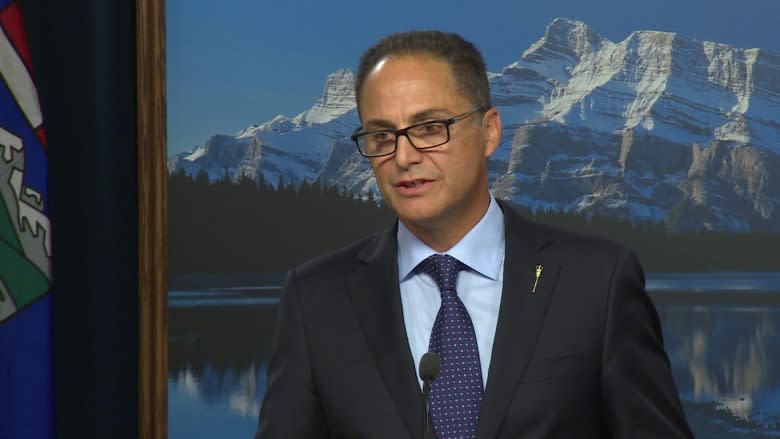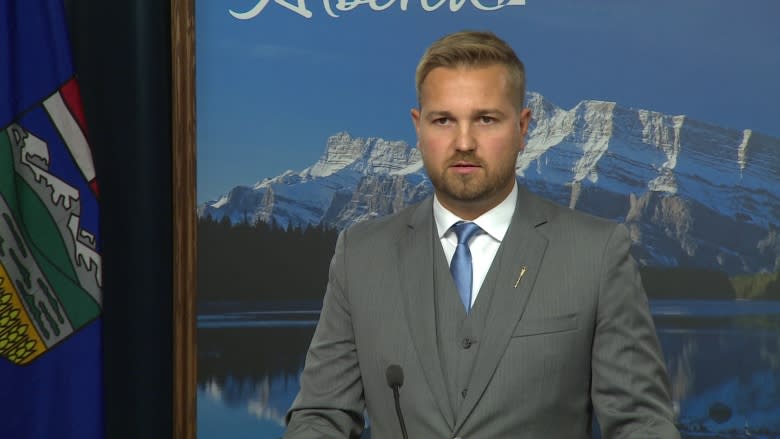Alberta deficit forecast at $5.9B as province feels impact of low oil prices
The effect of low oil prices is starting to make an impact on Alberta finances, according to the province's first-quarter update released Monday, and it could get worse.
A steep drop in the price of West Texas Intermediate crude in August is prompting finance officials to revise their estimates for the rest of the fiscal year.
Rachel Notley's NDP government is forecasting to end the year with a $5.9-billion deficit, $814 million more than forecast in the March 2015 budget, which was introduced but never passed by the previous Progressive Conservative government.
However, this forecast was finalized on July 30 before the price of WTI crude started dropping well below the $57.94 US a barrel average in April, May and June.
"It is clear that the revenues have dipped even further in these past weeks," said Finance Minister Joe Ceci. "If current conditions continue, the final deficit will be in the range of $6.5 billion."
Ceci said he will look for new sources of revenue, but ruled out the introduction of a provincial sales tax. He has told each ministry to look for items to trim from their budgets. However, he said the government will not cut essential services or fire thousands of public workers like teachers and doctors.
Ceci said the NDP inherited a bad situation from its predecessors.
"The previous conservative governments weren't able to balance Alberta's budget in five of the last six years when oil was averaging about $90 a barrel," he said.
"They failed to diversify the economy, failed to ensure that those that could were paying their fair share and failed to save for a rainy day."
Wildrose finance critic Derek Fildebrandt criticized the government for implementing tax increases that he says are hurting the economy but will only bring in $497 million.
He said the NDP is being unrealistic by basing its budget on oil staying at $55 a barrel for the rest of the year.
"Banking on an extra $700 million in extra royalties is without question, optimistic," he said.
Fildebrandt acknowledged the NDP inherited Alberta's financial problems but said they have to stop blaming the previous government.
"We need real action that rolls back risky experiments, reduces and controls spending, and has a vision for getting Alberta's financial house back in order," he said.
'Mild' recession
The 0.6 per cent contraction in GDP and an increasing unemployment rate, which was at 6.0 per cent in July, suggest Alberta is in a mild recession, according the government. About 139,000 Albertans will be out of work in 2015, 28,000 more than in 2014, the fiscal update forecasts.
Vehicle sales are down 9.2 per cent from the same time last year, according to the government. This is due to a decrease in the sales of expensive pickup trucks, another indication of how the drop in oil is affecting the resource sector.
The province is forecasting a $1-billion increase in revenue for 2015-16, partly due to an increase in corporate and personal income tax rates, which will add another $497 million to the treasury.
Expenses are forecast at $50.2 billion, $1.8 billion more than projected in the March budget. The government plans to draw nearly $3 billion from the contingency fund by the end of the fiscal year.
Disaster assistance is forecast to be the highest ever. Spending due to wildfires and drought is projected to be $757 million, $456 million more than forecast in March.
Total debt for capital projects is forecast at $18.3 billion. The government plans to borrow another $6.2 billion this year.
This may be the first time Alberta spends more than $50 billion in a year. However, new accounting practices now include $5 billion in liabilities for the so-called SUCH sector — school boards, universities, colleges and health entities.
The government plans to table a budget after the legislature resumes on Oct. 26. The budget tabled in March was never passed because the PC government was defeated on May 5.



